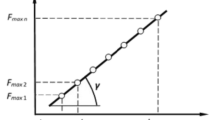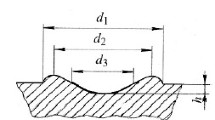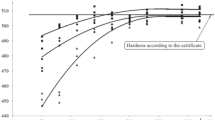A comparative analysis is performed for Brinell hardness values obtained with the help of different testing equipment and procedures for determining the mechanical characteristics of steels from the results of hardness testing used in the nuclear power engineering, including the testing unit and procedure developed at the Pisarenko Institute of Problems of Strength of the National Academy of Sciences of Ukraine.
Similar content being viewed by others
Avoid common mistakes on your manuscript.
Introduction. The monitoring of the technical condition of in-service equipment in power reactors of Ukraine is carried out using the typical program TPMK-10-01 [1]. According to this document, the characterization of the mechanical properties of structural materials from the results of hardness measurements is performed in accordance with the requirements of the regulations [2]. The analysis of the investigations on the improvement of the existing nondestructive testing methods has shown that the increase in the validity of correlations between the hardness numbers and characteristics of other properties of the material is of particular interest to specialists in this field. With this in view, a new regulation was put to use in Russia [3] which, in addition to the refined correlation relationships to assess the mechanical properties of metals after the different operating lives, covers the use of the instrumented indentation test method.
The most important condition for ensuring the stability and validity of the characterization of the mechanical properties from the hardness measurement results is the reliability and accuracy of the result of the hardness measurement by itself. The documents [1–3] for hardness measurements include the domestic production devices and their foreign analogues. The main methods used for determining the hardness are as follows: mechanical, contact-impedance (ultrasonic), dynamic methods, and the instrumented indentation tests. The parameter values obtained using the above methods are converted into the hardness numbers, and the accuracy of the measurement result depends on their correct conversion.
A comprehensive set of investigations has been conducted at the Pisarenko Institute of Problems of Strength of the National Academy of Sciences of Ukraine (hereinafter, the IPS NASU), which were aimed at the development and improvement of new methods for the characterization of the strength from the indentation and hardness test results, and also at the elaboration of new original equipment for instrumented indentation testing under laboratory and industrial conditions using different conditions of static and cyclic loading in the indentation force macrorange.
The goal of the present paper is to conduct the comparative hardness tests using different measuring instruments for determining the Brinell hardness and to analyze the procedures for determining the mechanical characteristics of the material from the results of hardness measurements according to the documents used in power engineering and the instrumented indentation testing, including the testing unit and procedure developed at the IPS NASU.
Testing Procedure and Equipment. The hardness testing equipment recommended in the documents [1–3], such as portable devices COMPUTEST SC (a mechanical hardness tester), MIC 10DL, a device of the Krautkramer series (ultrasonic testing equipment), TDM-1 (a dynamic device), stationary hardness testers types TSh-2 and KhPO-250, and the testing unit UTM-20 HT [4] developed at the IPS NASU, were used for comparative hardness tests by the Brinell method. The tests were performed using a reference hardness test block MTB in the form of a rectangular panel of 120 × 75 ×16 mm in size having a hardness of 182 HB. When measuring the hardness, all the requirements of the maintenance documents for the corresponding testing equipment were strictly followed.
The procedures described in [1–3] and developed at the IPS NASU [5] were used for the characterization of the mechanical properties of steels. The object of investigation was 10GN2IFA steel, which is widely used in the power engineering for manufacturing steam generators, pressurizers, collectors and other products. To avoid the effect of instrumental errors on the results of determination of the mechanical characteristics by the procedures described in [1, 3, 5], the hardness tests and instrumented indentation were carried out using the same laboratory testing unit UTM-20 HT [4].
The instrumented indentation testing was carried out in accordance with the requirements of the International Standard [6] under conditions of static and cyclic loading with a ball of 2.5 mm in diameter on rectangular specimens of 40 × 60 ×10 mm in size. Hardness was measured by the Brinell test method [7].
The mechanical characteristics of 10GN2IFA steel obtained from the tensile test data were determined according to the standard GOST 1484 [8] using the testing machine Instron, model 8802. The crosshead displacement speed was 0.01 mm/min. The type IV specimens having the gauge length l 0 = 12.5 mm with a diameter of 5 mm were tested. Strains were measured by a resistance strain gauge mounted on the gage-length section of the specimen.
Results of the Investigations and Their Discussion. The results of measuring hardness of the reference test block by the Brinell method using different testing equipment are given below: 180.7 IPa (TSh-2); 183.2 MPa (KhPO-250); 185.1 MPa (MIC 10DL); 179.4 MPa (COMPUTEST SC); 192.4 MPa (TDM-1); 182.6 MPa (UTM-20 HT). It is seen that the spread of the hardness is 8.3%. The maximum deviation of the test results from the hardness of the reference test block was obtained using the portable device TDM-1 (5.7%), the minimum deviation was obtained using hardness testers TSh-2, KhPO-250 and the testing unit UTM-20 HT (no greater than 1%). It is noteworthy that the maximum deviation specified in technical manuals for the device TDM-1 is 15%. The maximum spread of the results for portable devices is likely to be due to the fact that because of a low indentation depth, the hardness to be measured reflects, to a large extent, the properties of the surface layer of metal, whereas the hardness measured with stationary devices is related to the bulk material. The performed comparative test results indicate the following:
-
(i)
for reliable assessment of the metal degradation, the tests are to be performed using a single device. When using two devices, the spread of the measured hardness values obtained with these devices on the reference test block is to be pointed out;
-
(ii)
when selecting the device for measuring the hardness of structural elements, it is necessary to start from the volume of the deformed material, namely: to use devices with low loads for determining the hardness of the surface layer of the metal, and those with high loads for measuring the bulk material hardness;
-
(iii)
a correct measurement of the hardness depends on the accuracy of the device used in determining the hardness, and the number of measurements;
-
(iv)
the procedure and equipment developed at the IPS NASU, can be used to measure the Brinell hardness using the instrumented indentation test method.
Table 1 illustrates the determination of the mechanical characteristics from the hardness test data and by the instrumented indentation test method together with their deviation from the tensile testing results.
The comparison between the results of investigations using the procedures for determining the strength characteristics from the hardness tests shows that the correlation relationships for steel 10GN2MFA given in [1–3] are, in general, valid provided that the relative deviation of certain strength characteristics obtained using the hardness measurement results from those determined using the tensile test results does not exceed 10%. The exception is the correlation relationship for assessing the yield stress [2], with the use of which the deviation reaches 21%. It is noteworthy that more valid results of determination of the mechanical characteristics from the results of hardness measurements are obtained using the regulations [3].
The analysis of the investigation results obtained by the instrumented indentation test method using different procedures (see Table 1) testifies that the deviation of the mechanical characteristics of the steel under study determined in the tensile tests exceeds 10 %. At the same time, the values of the tensile strength and yield stress determined using the procedure of the IPS NASU are within the deviations as specified according to the standard document currently in force [1].
The comparative analysis has shown that:
-
the correlation relationships in [1] for determining the strength characteristics of the 10GN2MFA steel with consideration of the above deviation (no more than 10 %) are valid for the tensile strength, whereas in the case of the yield stress, they must be corrected;
-
the results of determination of the mechanical characteristics by the instrumented indentation test method according to the procedure of the IPS NASU, are more reliable than those obtained according to the procedure in [3]. The deviation of the tensile strength values obtained according to the procedure developed at the IPS NASU from those obtained in the tensile tests does not exceed 5,5 %, and that of the yield stress does not exceed 1%.
Conclusions
-
1.
The comparative tests of different measurement instruments for determination of the Brinell hardness were performed. It has been shown that the spread of the Brinell hardness value obtained with different instruments using reference test block is 8.3%.
-
2.
The most reliable results on determination of the mechanical characteristics of steel 10GN2MFA were obtained using the procedures of the IPS NASU. The deviation of the tensile strength values obtained according to the procedure of the IPS NASU from those obtained in the tensile tests does not exceed 5.5%, and that of the yield stress does not exceed 1%.
-
3.
It has been experimentally corroborated that the testing unit UTM-20 HT can be used for the measurement of hardness and assessment of the strength characteristics according to the regulations currently in force in Ukraine [1].
References
TPKM-10-01. Typical Program for Periodic Testing of the Mechanical Properties of Metal in Pipelines of WWER-1000 NPP [in Russian], Kiev (2001).
RD ÉO 0027–94. Regulations on the Characterization of the Mechanical Properties of Metal in the Equipment of Nuclear Power Plants Using Specimen-Free Methods from the Characteristics of Hardness [in Russian], Vol. 1, 2, Rosénergoatom Concern, Moscow (1994).
RD ÉO 0027–2005. Regulations on the Determination of the Mechanical Properties of Metal in the Equipment of Nuclear Power Plants Using Specimen-Free Methods from the Characteristics of Hardness [in Russian], Rosénergoatom Concern, Moscow (2006).
V. V. Kharchenko, N. P. Rudnitskii, O. A. Katok, et al., “Set-up for the determination of mechanical characteristics of structural materials by the instrumented indentation test,” in: Reliability and Life of Machines and Structures [in Russian], Issue 27, Kiev (2007), pp. 140–147.
V. V. Kharchenko, O. A. Katok, A. V. Panasenko, et al., “Investigation on strength characteristics of steam generator welded joint after operational life using instrumented indentation test method,” Strength Mater., 45, No. 3, 295–300 (2013).
ISO 14577–1:2002. Metallic Materials – Instrumented Indentation Test for Hardness and Materials Parameters. Test Method.
GOST 9012–59. Metals. Method for Measuring Brinell Hardness [in Russian], Introduced since January 1, 1960.
GOST 1497–84. Metals. Methods of Tensile Testing [in Russian], Introduced since January 1, 1986.
Author information
Authors and Affiliations
Additional information
Translated from Problemy Prochnosti, No. 6, pp. 66 – 70, November – December, 2014.
Rights and permissions
About this article
Cite this article
Katok, O.A., Rudnitskii, N.P., Kharchenko, V.V. et al. On the Determination of the Mechanical Characteristics of Steels from Hardness Test Results. Strength Mater 46, 773–776 (2014). https://doi.org/10.1007/s11223-014-9610-2
Received:
Published:
Issue Date:
DOI: https://doi.org/10.1007/s11223-014-9610-2




